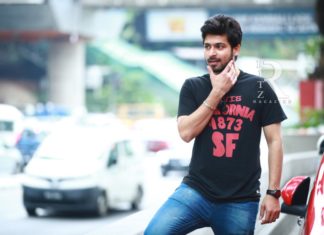Rajoupacharam allows you to revel in Kingly repast as award-winning Chef Shri Bala curates ancient forgotten recipes
BY NAMITA GUPTA

You cannot go back in time and live like the royals did. You could probably stretch your imagination to a time when India was filled with myriad history, traditions, customs and cuisines. But if you want to truly experience the livelihood and cultures of the era gone by, then the best way is by indulging in the foods they consumed. That is why Chef Shri Bala went on an exploratory journey to curate the dishes from the royal kitchens, to give you a taste of how they were in the good old days. With centuries of rich heritage and royal kingdoms, coupled with incredible cooks and richest of the ingredients, the culinary traditions of the yore were nothing short of exemplary tales. The dishes from the royal kitchens reflected the eating habits and livelihood of the countrymen, depending upon the geographies. In addition to being rich and extravagant, the food focused on overall health and wellness. Going back in time and studying royal cuisines reveals many new facets of how our food culture emerged. The use of chillies in our food emerged when the Dutch plundered the pepper and brought chilli to our land. It was pepper that was predominantly used in Indian royal kitchens before chilli was discovered. Rice was a staple even during the Sangam time; however, it was only the kings, who ate rice, while the commoners’ staple was millets, which is now considered a superfood by the millennials.

Formerly a Company Secretary and now a food researcher and Chef, Chef Shri Bala’s curiosity piqued her interest towards plunging into a fully-fledged career as a researcher of forgotten recipes. Through expansive researches online and numerous library visits across the Southern Peninsular, she has discovered many recipes, which she brings forth to food connoiseurs. Since then, she has been curating traditional forgotten recipes for food festivals across various hotels. She is also currently pursuing her PhD in Ancient Cuisines and Evolution of Food from Sangam Times to now.
There’s no better way to embark on a time travelling adventure and indulge in forgotten recipes. As part of the pan-India celebration to commemorate 30 successful years of Dakshin, the signature brand celebrates the rich diversity of South Indian cuisine with Chef Shri Bala showcasing the royal cuisines of south Indian kingdoms of Chola, Kakatiya, Vijayanagara and Sethupathi at Dakshin at ITC Windsor. The food festival is aptly named ‘Rajoupacharam’, meaning, a royal feast under the Kitchens of India initiative – Royal Repast.
Begin your meal with Nannari which is Sarsaparilla root extract juice and bite into Beyisida Bidiru Molake Kadubu which is steamed bamboo sprout cakes, Banana Dosa Sarva Pindi or rice flour pancake seasoned with peanut and bengal gram, Menthi Kadubu or fenugreek leaves and wheat flour dumplings, Masaleyukta Hasi Halasinakayi Undde, which is spicy tender raw jackfruit dumplings batter fried with betel leaves. Non-vegetarians will love Meenu Suska or pan-seared fish in coconut poppy seeds paste, Eral Varai or prawns tossed in black pepper masala, Kothina Kari or minced mutton with spiced ‘urud’ crumble and Kaadai Milagu Piratal or quail black pepper fry. Wash these delicious one bite wonders with some Pathimugan, a red coloured herb water that gets its colour from Sappan wood.

A beautifully plated thali is served for main course. Pick from either a vegetarian thali or saivam as it’s called, chicken and lamb thali or asaivam or a fish and seafood thali called the matsyam. Some of the lip-smacking bowls that are high on flavours in the vegetarian thali include Patchi Pulusu, uncooked tamarind rasam, Sennai Seppan Varuval, colocacia and elephant foot yam deep fried dry curry, Uluva Charu – horse gram rasam, Badanekayi Palya, stuffed eggplant curry, Ezhu Kari Kootu, select seven country vegetables and ‘motchai’ beans curry, Bale, Bale Hoovina Huli – plantain and plantain flower curry, Iddalige – buttermilk cured & tamarind infused ‘urud’ crumble encased in wheat roti and deep fried, Benne Chikitse Anna, butter infused rice slow steam cooked in four layered ‘muslin’, Kootan Soru, one pot meal with select vegetables & rice, encased in ‘lotus leaf’ and Mossuru Bhutti – curd rice dumpling with spicy green chutney. Besides all these vegetarian dishes, the additions on the asaivam thali include Kootu Kozhi Kalari or country chicken slow cooked with ‘pandan’ & raw banana, Golichina Mamsam or mutton cooked with special blend of spices and Perunsoru or one pot meal of spiced mutton and rice encased in ‘lotus leaf’. Being a fish lover, my favourites were the Vanjaram Meen Kozhambu or smoked seer fish curry cooked with ‘kudampuli’, Nandu Ulli Theeyal or crab cooked with shallots, coconut and tamarind and Perunsoru or one pot meal of spiced mutton and rice encased in ‘lotus leaf’ in the Matsyam thali.
Do leave space to taste some unique and delectable desserts like Paruthipal Pongal (cottonseed milk Pongal with palm jaggery) in addition to Akki hesurubele payasam adding the sweet touch to the exhaustive royal menu.















